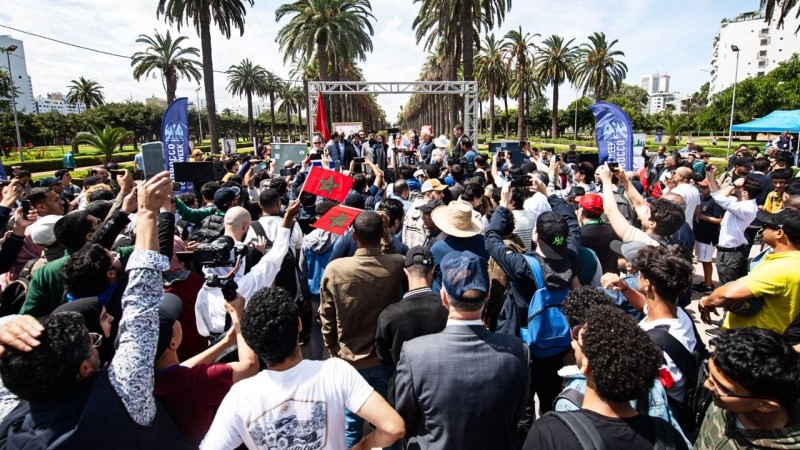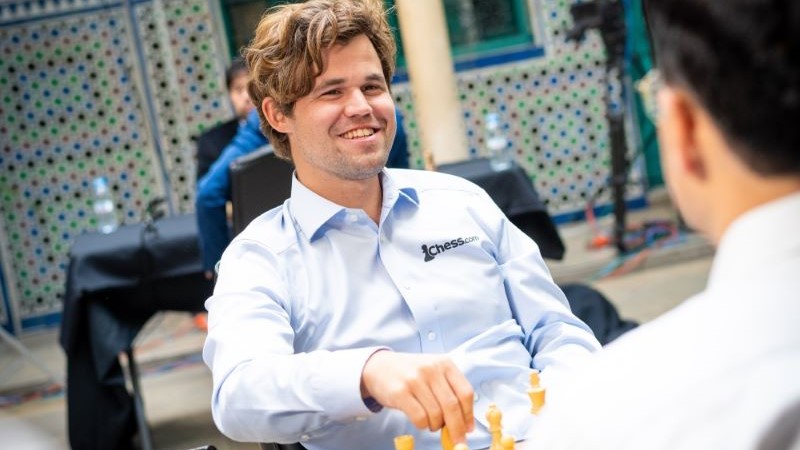FIDE 100 celebrations reach Morocco

The centenary celebrations of the International Chess Federation are unfolding across the globe, and sunny Casablanca in Morocco has been chosen as the African host city for this momentous occasion. On Saturday, May 18, a significant event took place at the Parc de la Ligue Arabe in the heart of Casablanca. During the opening ceremony of Morocco Chess Week, FIDE President Arkady Dvorkovich delivered a speech emphasizing the historical significance of the celebration: “It’s not just an event; it’s one of the central elements of our 100-year anniversary celebration this year. We are looking at our history. We started in India, where chess was most likely born; we went to Switzerland, where, for many years, FIDE headquarters has been located, and now we are in Morocco, where chess most likely came to Europe. It’s about our roots.” The festivities commenced with the Chess Olympiad Torch Relay. The torch’s journey began in India, where the 44th Chess Olympiad took place in 2022. From there, it traveled to Ghana, Switzerland, Canada and finally arrived in Morocco. The enthusiastic crowd of chess fans gathered in the park, welcomed by live traditional Moroccan music performed by expressive musicians. FIDE officials graced the stage, with FIDE President Arkady Dvorkovich, Deputy Chair of Management Board Dana Reizniece-Ozola, and Continental President for Africa Tshepiso Lopang, among other distinguished guests. The audience erupted with excitement as grandmasters Hikaru Nakamura, Viswanathan Anand (FIDE Deputy President), and local hero, 7-time African champion Bassem Amin made their appearances. Later that day, Magnus Carlsen joined them in a rapid tournament, showcasing the innovative Casablanca chess variant. “Welcome to Morocco, welcome to Africa, and welcome to the Arab world!” exclaimed the ceremony’s host. The anthems of Morocco and FIDE were played. FIDE President delivered an inspired speech, finishing with words that caused great applause: “This celebration highlights the importance of Morocco and Casablanca in the chess world. It demonstrates our commitment to advancing the game and underscores our unity. The game is just beginning—another century for chess!” “To be honest, I’ve never seen such enthusiasm for chess. To see all the people who are out here today…” the words of Hikaru Nakamura were drowned in cheering from the crowd. “…I hope it will inspire you to play more chess and enjoy everything about the game!” Anand and Nakamura’s speeches ignited chants of “Bassem! Bassem! Bassem!” in honor of the African hero, who addressed the audience in Arabic. The torch relay continues, with upcoming stops in Colombia and Kazakhstan. The flame was passed to Darmen Sadvakasov, 1st Vice-President of the Kazakhstan Federation, and Executive Director Gulmira Dauletova. Following the torch ceremony, a massive 100-player simultaneous exhibition unfolded in one of the park’s shadowy alleys. The local talents were tested by IM Mohamed Tissir, GM Laurent Fressinet, GM Alexander Volzhin, WGM Atousa Pourkashiyan, WGM Gulmira Dauletova, WGM Dana Reizniece-Ozola, Nadezhda Marochkina, WIM Tshepiso Lopang, Benard Wanjala, and GM Bashar Kouatly; each of them faced ten opponents. The simul lasted for several hours, with some participants securing draws or even wins against the seasoned players. In another alley of the park, attendees admired brilliant photographs by Stev Bonhage. His exhibition, titled “Capture,” travels the world, showcasing the art of chess and photography. The pictures feature professional chess players, random strangers, the elderly, and children—all united by their love for the game. After the exciting day under the sun, the public and distinguished guests moved to the beautiful Mechouar Palace to watch Carlsen, Nakamura, Anand, and Amin battle in the Casablanca Chess rapid tournament. Written by Anna Burtasova, Casablanca Chess Press Officer Photos: Stev Bonhage
Casablanca Chess: Carlsen takes the lead on Day 1

Casablanca Chess made a strong impression on the first day of play in Morocco. The innovative format, where players begin in positions selected from historical games, brought excitement to both participants and spectators. Following three rounds and six rapid games Magnus Carlsen is leading with 2.5 points (wins against Anand and Nakamura, a draw with Amin). Hikaru Nakamura is in second place with 1.5 points (a win against Amin, a draw with Anand, and a loss from Carlsen). Viswanathan Anand and Bassem Amin both find themselves at the bottom of the tournament table with 1 point each (two draws and one loss). The first-round position was selected by the broadcast commentators, grandmasters Jan Gustafsson and Daniel Naroditsky. They had three options: Chigorin-Steinitz 1889, Lasker-Tarrasch 1908, and Rubtsova-Bykova 1958. “Just for pure excitement, we have to go with number 1,” said Gustafsson. “That’s an Evans Gambit, a 19th-century style!” Naroditsky chimed in. This is how the players transported themselves back to 1889, revisiting a World Championship match in Havana. They began from the 11th move, a departure from Wilhelm Steinitz’s original 11. dxe5 – a move that none of our participants replicated. Magnus Carlsen opted for 11. Na3. A few moves later, Viswanathan Anand took a daring path with his queen, only to find it trapped shortly afterward. White secured victory in just 20 moves. Hikaru Nakamura, with White against Bassem Amin, started with a solid 11. Bf1 but very soon sacrificed both rooks, gaining a queen in return and achieving a winning position. The American wrapped it up with a nice bishop sacrifice. 24. Bf6! h6 (24…fxf6 25. exf6 Bb4 26. Bd3) 25. Qf4 Bb4 26. Bd3 d5 27. Bxg7 Kxg7 28. Qf6+ 1-0 This game lasted a little longer, White won too, putting Carlsen and Nakamura in an early lead. Bassem commented, “The starting position may appear equal, but as Black, you’re on the defensive side, and one wrong move can destroy everything.” Offering his thoughts, Anand said, “I liked the idea [of the Casablanca chess variant], but I haven’t given it much thought; it just seemed like something fun. The position from the first game is challenging to grasp in rapid play. And having only two minutes before the start is very little to think of anything. It feels like being thrown into the deep end every time. Let’s see if it gets better!” For the second round, the players themselves voted on the position. The options were Graf-Menchik 1934, Xie-Galliamova 1999, and Smyslov-Botvinnik 1957. Not knowingly, Anand, Nakamura, and Bassem all chose different ones, so it was ultimately Carlsen’s decision that sealed the deal. The players began their game at move 11 in Game 10 of the Xie Jun vs. Alisa Galliamova Women’s World Championship Match in Kazan/Shenyang in 1999. In the original game, Xie chose 11. Be3. Bassem, playing White against Carlsen, followed a similar path. The players continued the game until move 19 when Carlsen deviated by playing 19… Rc8 instead of Galliamova’s 19… Re4. In the ensuing rook endgame, Carlsen managed to win a pawn, but it still resulted in an easy draw for White. The game concluded uneventfully on move 46. Anand also selected 11. Be3, but in this game, Nakamura (playing as Black) deviated earlier. At move 15, Nakamura opted for an intermediate move, 15… Bc5, rather than 15… Bf6.The game quickly transitioned into a drawish rook endgame, and the players split the point on move 49 through a threefold repetition. Notably, players are not allowed to offer a draw at any moment during the game. The third position was determined by a popular vote during the broadcast. The audience had to choose between three famous world championship matches: Alekhine vs. Capablanca (1927), Spassky vs. Fischer (1972), and Karpov vs. Kasparov (1985). Ultimately, they opted for the latter. Bassem vs Anand and Nakamura vs Carlsen started from move 12 in the 14th game of the 1985 Karpov-Kasparov match. The players followed the original game with 12. Nd5 Rc8 and 13. c3. However, Anand deviated by capturing a pawn on h4 (13… Bxh4), digressing from the predecessors, and the game finished in a draw by repetition just a couple of moves later. Carlsen, on the other hand, adhered to the original game with 13… Nf6 but then made an unorthodox move on the next turn, playing 14…Kxe7 instead of Kasparov’s 14…Qxe7. After 15. g5 Ng4 16. Bc1 hxg5 Hikaru made a serious mistake with 17. Bf3? (17. f3 Nf6 18. Bxg5 and White is fine). Magnus quickly gained an advantage with 17…Qd7! 18. Rg1 Nh2 19. Bg5+ f6 and won the game on move 35. After the day was over, Carlsen shared his impressions: “It’s a fun format. I think what happened in the second game was a bit of a shame as it all liquidated to a draw pretty quickly.” Answering whether he recognized any of the starting positions, Carlsen replied: “The last game looked very similar to Karpov-Kasparov games from the second match, and I seemed to remember that Garry’s knight ended up on g4 and maybe h2. But that was about it. The first game I thought it has to be a Steinitz game since he’s the only one who plays like that. Probably against Chigorin, as they had a World Championship match in 1889, and there were a lot of Evans gambits. The second one, I had no clue!” The play will resume on Sunday, May 19, with three more rounds. Photos (please attribute the photographer when using): DropboxLive Broadcast: Casablanca Chess 2024 – Chess.comOfficial Website: Casablanca-Chess Written by Anna Burtasova, Casablanca Chess Press Officer Photos by Lennart Ootes

